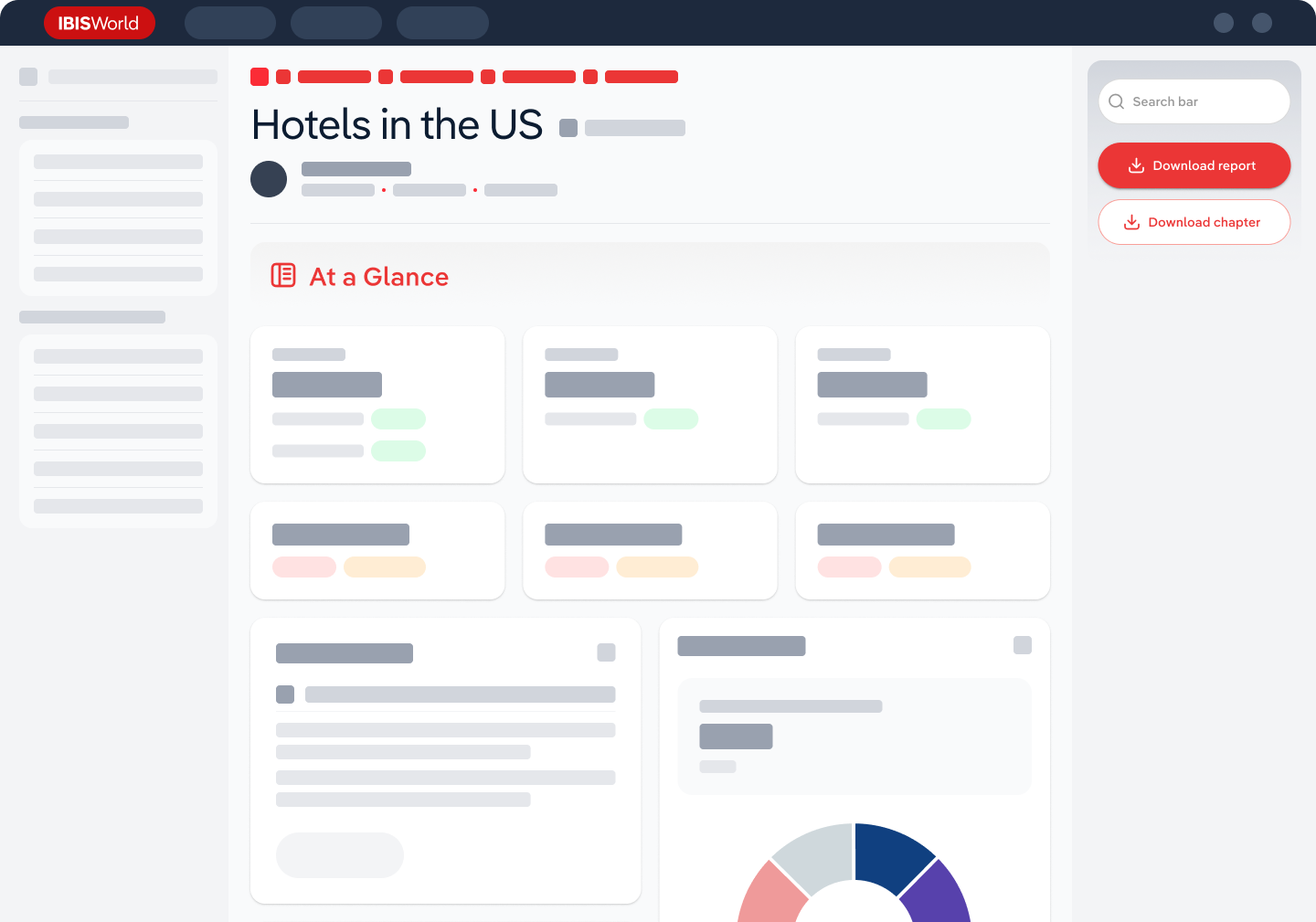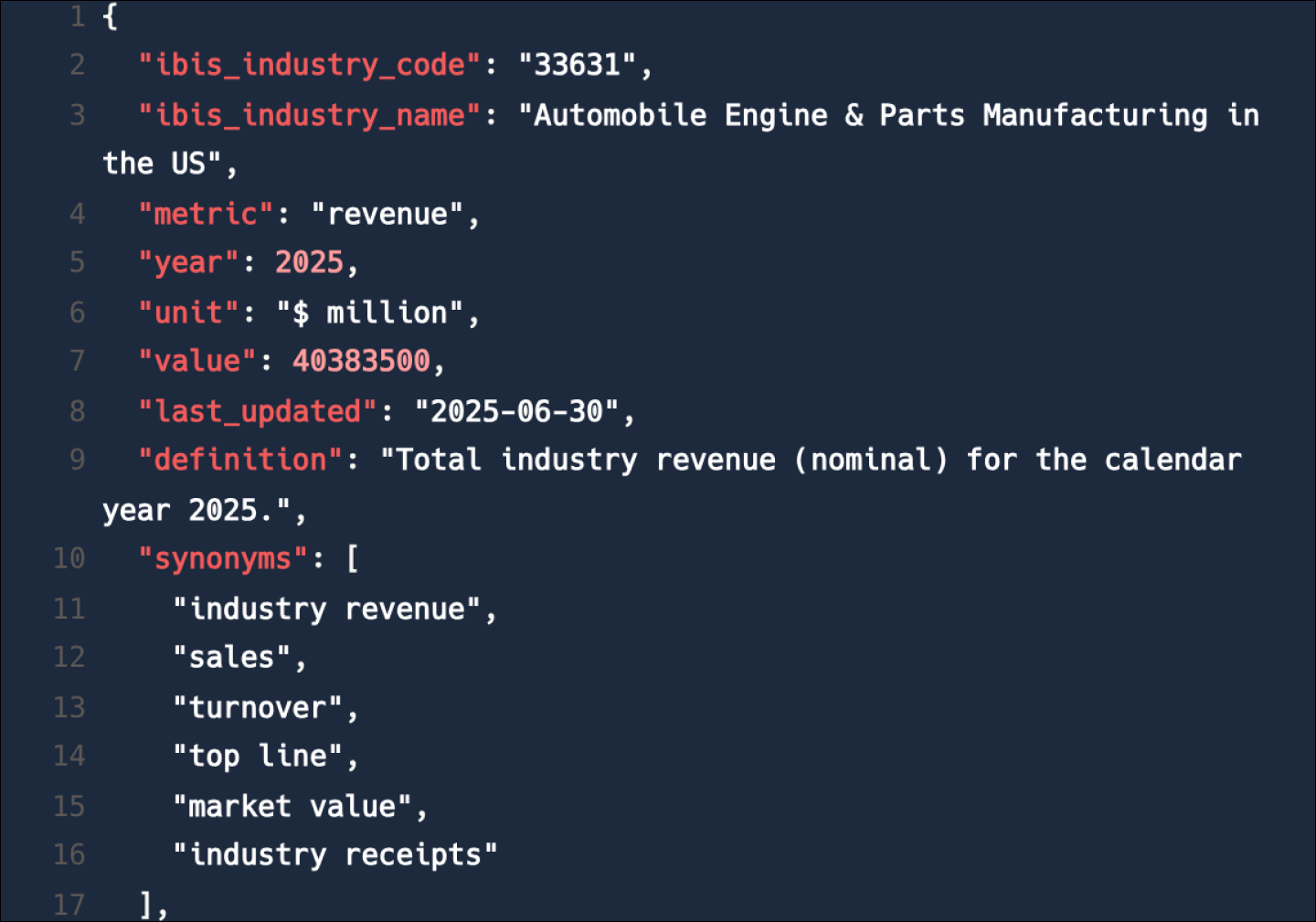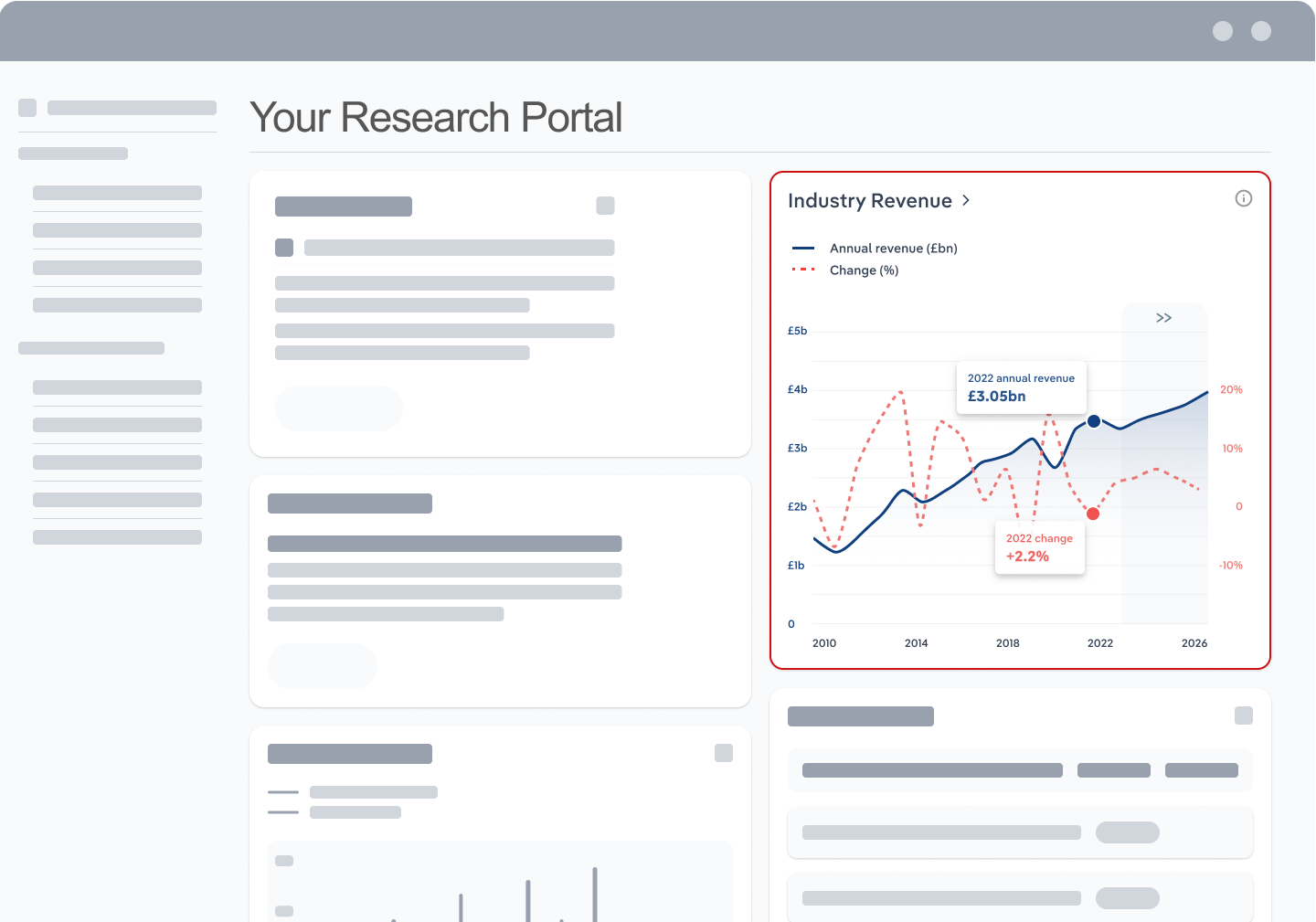Industry Statistics and Trends
Market size and recent performance (2015-2030)
Industry revenue has grown at a CAGR of 5.4 % over the past five years, to reach an estimated €11.4bn in 2025.
Trends and Insights
The industry is benefiting from the growing demand for cloud solutions
- According to the "Cloud Report 2025: Status Quo and Trends in Business and Politics", a study by the digital association Bitkom, for which 604 companies in Germany were surveyed, 90% of companies will be using cloud computing in 2025, compared to 81% in 2024. A further 10% are planning or discussing the introduction. The private cloud is particularly widespread, being used by 74% of companies, while public cloud offerings are used by 59% of the companies surveyed. Companies cite the digitalisation of internal processes, increased IT security, migration to SaaS platforms, cost efficiency, the development of collaboration platforms, a reduction in CO₂ emissions and access to innovative technologies such as AI and IoT as the main objectives of cloud use. According to the study, 32% of companies are planning to "tend to increase" their cloud investments in 2025 compared to 2024, while 14% are planning a significant increase.
- Additional trends and insights available with purchase
Industry outlook (2025-2030)
Market size is projected to grow over the next five years.
Trends and Insights
Industry players are likely to consolidate their position as partners for digital transformation in the future
- The study "Cloud Report 2025: Status Quo and Trends in Business and Politics" published by the digital association Bitkom shows a significant change in the use of cloud solutions by German companies. While 62% of the 604 companies surveyed currently obtain databases and 56% security software via the cloud, these rates are expected to rise to 75% and 70% respectively by 2030. The adoption of cloud-based AI services is expected to grow particularly rapidly. The proportion of companies using such applications is expected to grow from 26% to 51% between 2025 and 2030.
Biggest companies in the Data Processing & Hosting Services in Germany
| Company | Market Share (%)
2025 | Revenue (€m)
2025 |
|---|---|---|
Microsoft Deutschland GmbH | 3,874.0 | |
SAP SE | 2,501.4 | |
Salesforce.com Germany GmbH | 1,188.0 |
To view the market share and analysis for all 7 top companies in this industry, view purchase options.
Products & Services Segmentation
Industry revenue is measured across several distinct product and services lines, including Cloud computing, Data processing and Webhosting. Cloud computing is the largest segment of the Data Processing & Hosting Services in Germany.
Trends and Insights
Cloud computing facilitates companies' business activities and is therefore increasingly in demand
- Cloud computing is the provision of computer system resources such as storage capacity, computing power and applications for companies by cloud providers on demand.
- More insights available in the full report
Table of Contents
About this industry
Industry definition
The data processing and data hosting sector includes activities such as web hosting, the provision of streaming services and the external provision of applications. This includes the marketing of computing time on mainframes and various data processing activities such as the analysis of customer data. The sector does not include activities in which data processing systems are only used as an aid.
What's included in this industry?
Products and services covered in the Data Processing & Hosting Services industry in Germany include Cloud computing, Data processing, Webhosting and Streaming.Companies
Companies covered in the Data Processing & Hosting Services industry in Germany include Microsoft Deutschland GmbH, SAP SE and Salesforce.com Germany GmbH.Purchase this report to view all 7 major companies in this industry.
Related Terms
Related terms covered in the Data Processing & Hosting Services industry in Germany include blockchain, cloud computing, enterprise resource planning (erp) system, hosting and search engine optimisation (seo).Industry Code
WZ 63.11 - Data Processing & Hosting Services in Germany
Performance
Get an indication of the industry's health through historical, current and forward-looking trends in the performance indicators that make or break businesses.
Analyst insights
The data processing and data hosting industry in Germany is benefiting massively from the cloud boom and the integration dynamics of AI and IoT solutions. Scalable, secure an...
In this chapter (4)
- Current Performance
- Outlook
- Volatility
- Life Cycle
Key metrics
- Annual Revenue, Recent Growth, Forecast, Revenue Volatility
- Number of Employees, Recent Growth, Forecast, Employees per Business, Revenue per Employee
- Number of Businesses, Recent Growth, Forecast, Employees per Business, Revenue per Business
- Total Profit, Profit Margin, Profit per Business
Charts
- Revenue, including historical (2015-2024) and forecast (2025-2030)
- Employees, including historical (2015-2024) and forecast (2025-2030)
- Businesses, including historical (2015-2024) and forecast (2025-2030)
- Profit, including historical (2015-2025)
- Industry Volatility vs. Revenue Growth
- Industry Life Cycle
Detailed analysis
- Trends in supply, demand and current events that are driving current industry performance
- Expected trends, economic factors and ongoing events that drive the industry's outlook
- Key success factors for businesses to overcome volatility
- How contribution to GDP, industry saturation, innovation, consolidation, and technology and systems influence the industry's life cycle phase.
Products and Markets
Learn about an industry's products and services, markets and trends in international trade.
Analyst insight
The ever-increasing volume of data is leading to an increase in demand for data processing services. Technologies from the field of artificial intelligence and big data analy...
In this chapter
- Products & Services
- Major Markets
Key metrics
- Largest market segment and value in 2025
- Product innovation level
Charts
- Products & services segmentation in 2025
- Major market segmentation in 2025
Detailed analysis
- Trends impacting the recent performance of the industry's various segments
- Innovations in the industry's product or service offering, specialization or delivery method
- Key factors that successful businesses consider in their offerings
- Buying segments and key trends influencing demand for industry products and services
Geographic Breakdown
Discover where business activity is most concentrated in an industry and the factors driving these trends to find opportunities and conduct regional benchmarking.
Analyst insights
The Central region accounts for the largest share of industry companies. Of particular importance is the Frankfurt am Main location as an important hub for the Internet infra...
In this chapter (1)
- Business Locations
Charts
- Share of revenue, establishment, wages and employment in each region
- Share of population compared to establishments in each region in 2025
Tables
- Number and share of establishments in each region in 2025
- Number and share of revenue each region accounts for in 2025
- Number and share of wages each region accounts for in 2025
- Number and share of employees in each region in 2025
Detailed analysis
- Geographic spread of the industry across Europe, and trends associated with changes in the business landscape
- Key success factors for businesses to use location to their advantage
Competitive Forces
Get data and insights on what's driving competition in an industry and the challenges industry operators and new entrants may face, with analysis built around Porter's Five Forces framework.
Analyst insights
Some companies prefer to operate their IT infrastructure themselves on site instead of migrating to the cloud. The main reasons for this are concerns about performance and th...
In this chapter (4)
- Concentration
- Barriers to Entry
- Substitutes
- Buyer & Supplier Analysis
Key metrics
- Industry concentration level
- Industry competition level and trend
- Barriers to entry level and trend
- Substitutes level and trend
- Buyer power level and trend
- Supplier power level and trend
Charts
- Market share concentration among the top 4 suppliers from 2020-2025
- Supply chain including upstream supplying industries and downstream buying industries, flow chart
Detailed analysis
- Factors impacting the industry’s level of concentration, such as business distribution, new entrants, or merger and acquisition activity.
- Key success factors for businesses to manage the competitive environment of the industry.
- Challenges that potential industry entrants face such as legal, start-up costs, differentiation, labor/capital intensity and capital expenses.
- Key success factors for potential entrants to overcome barriers to entry.
- Competitive threats from potential substitutes for the industry’s own products and services.
- Key success factors for how successful businesses can compete with substitutes.
- Advantages that buyers have to keep favorable purchasing conditions.
- Advantages that suppliers have to maintain favorable selling conditions.
- Key success factors for how businesses can navigate buyer and supplier power.
Companies
Learn about the performance of the top companies in the industry.
Analyst insights
Microsoft Azure enables customers to completely outsource their IT infrastructure to the cloud. Azure impresses with its great flexibility, as the cloud infrastructure can be...
In this chapter
- Market Share Concentration
- Companies
- Company Spotlights
Charts
- Industry market share by company in 2021 through 2025
- Major companies in the industry, including market share, revenue, profit and profit margin in 2025
- Overview of Microsoft Deutschland GmbH's performance by revenue, market share and profit margin from 2019 through 2025
- Overview of SAP SE's performance by revenue, market share and profit margin from 2019 through 2025
- Overview of Salesforce.com Germany GmbH's performance by revenue, market share and profit margin from 2019 through 2025
- Overview of revenue, market share and profit margin trend for 4 additional companies
Detailed analysis
- Description and key data for Microsoft Deutschland GmbH, and factors influencing its performance in the industry
- Description and key data for SAP SE, and factors influencing its performance in the industry
- Description and key data for Salesforce.com Germany GmbH, and factors influencing its performance in the industry
- Description, key data and performance trends for 4 additional companies
External Environment
Understand the demographic, economic and regulatory factors that shape how businesses in an industry perform.
Analyst insights
A deterioration in the business climate affects the sales development of the data processing and hosting industry. A deterioration in the business climate is usually accompan...
In this chapter
- External Drivers
- Regulation & Policy
- Assistance
Key metrics
- Regulation & policy level and trend
- Assistance level and trend
Charts
- Regulation & Policy historical data and forecast (2015-2030)
- Assistance historical data and forecast (2015-2030)
Detailed analysis
- Demographic and macroeconomic factors influencing the industry, including Regulation & Policy and Assistance
- Major types of regulations, regulatory bodies, industry standards or specific regulations impacting requirements for industry operators
- Key governmental and non-governmental groups or policies that may provide some relief for industry operators.
Financial Benchmarks
View average costs for industry operators and compare financial data against an industry's financial benchmarks over time.
Analyst insights
The need for qualified employees results in high personnel costs. Due to the rapid growth of the technology sector, the required IT specialists are among the most sought-afte...
In this chapter
- Cost Structure
- Financial Ratios
- Key Ratios
Key metrics
- Profit margin, and how it compares to the sector-wide margin
- Average wages, and how it compares to the sector-wide average wage
- Largest cost component as a percentage of revenue
- Industry average ratios for days' receivables, industry coverage and debt-to-net-worth ratio
Charts
- Average industry operating costs as a share of revenue, including purchases, wages, depreciation, utilities, rent, other costs and profit in 2025
- Average sector operating costs as a share of revenue, including purchases, wages, depreciation, utilities, rent, other costs and profit in 2025
- Investment vs. share of economy
Data tables
- Cash Flow & Debt Service Ratios (2015-2030)
- Revenue per Employee (2015-2030)
- Revenue per Enterprise (2015-2030)
- Employees per Establishment (2015-2030)
- Employees per Enterprise (2015-2030)
- Average Wage (2015-2030)
- Wages/Revenue (2015-2030)
- Establishments per Enterprise (2015-2030)
- IVA/Revenue (2015-2030)
- Imports/Demand (2015-2030)
- Exports/Revenue (2015-2030)
Detailed analysis
- Trends in the cost component for industry operators and their impact on industry costs and profitability
Key Statistics
Industry Data
Data Tables
Including values and annual change:
- Revenue (2015-2030)
- IVA (2015-2030)
- Establishments (2015-2030)
- Enterprises (2015-2030)
- Employment (2015-2030)
- Exports (2015-2030)
- Imports (2015-2030)
- Wages (2015-2030)
Top Questions Answered
Unlock comprehensive answers and precise data upon purchase. View purchase options.
What is the market size of the Data Processing & Hosting Services industry in Germany in 2025?
The market size of the Data Processing & Hosting Services industry in Germany is €11.4bn in 2025.
How many businesses are there in the Data Processing & Hosting Services industry in Germany in 2025?
There are 1,925 businesses in the Data Processing & Hosting Services industry in Germany, which has grown at a CAGR of 5.1 % between 2020 and 2025.
How may import tariffs affect the Data Processing & Hosting Services industry in Germany?
The Data Processing & Hosting Services industry in Germany is unlikely to be materially impacted by import tariffs with imports accounting for a low share of industry revenue.
How may export tariffs affect the Data Processing & Hosting Services industry in Germany?
The Data Processing & Hosting Services industry in Germany is unlikely to be materially impacted by export tariffs with exports accounting for a low share of industry revenue.
Has the Data Processing & Hosting Services industry in Germany grown or declined over the past 5 years?
The market size of the Data Processing & Hosting Services industry in Germany has been growing at a CAGR of 5.4 % between 2020 and 2025.
What is the forecast growth of the Data Processing & Hosting Services industry in Germany over the next 5 years?
Over the next five years, the Data Processing & Hosting Services industry in Germany is expected to grow.
What are the biggest companies in the Data Processing & Hosting Services industry in Germany?
The biggest companies operating in the Data Processing & Hosting Services industry in Germany are Microsoft Deutschland GmbH, SAP SE and Salesforce.com Germany GmbH
What does the Data Processing & Hosting Services industry in Germany include?
Cloud computing and Data processing are part of the Data Processing & Hosting Services industry in Germany.
Which companies have the highest market share in the Data Processing & Hosting Services industry in Germany?
The company holding the most market share in the Data Processing & Hosting Services industry in Germany is Microsoft Deutschland GmbH.
How competitive is the Data Processing & Hosting Services industry in Germany?
The level of competition is moderate and increasing in the Data Processing & Hosting Services industry in Germany.
Methodology
How are IBISWorld reports created?
IBISWorld has been a leading provider of trusted industry research for over 50 years to the most successful companies worldwide. With offices in Australia, the United States, the United Kingdom, Germany and China, we are proud to have local teams of analysts that conduct research, data analysis and forecasting to produce data-driven industry reports.
Our analysts start with official, verified and publicly available sources of data to build the most accurate picture of each industry. Analysts then leverage their expertise and knowledge of the local markets to synthesize trends into digestible content for IBISWorld readers. Finally, each report is reviewed by one of IBISWorld’s editors, who provide quality assurance to ensure accuracy and readability.
IBISWorld relies on human-verified data and human-written analysis to compile each standard industry report. We do not use generative AI tools to write insights, although members can choose to leverage AI-based tools within the platform to generate additional analysis formats.
What data sources do IBISWorld analysts use?
Each industry report incorporates data and research from government databases, industry-specific sources, industry contacts, and our own proprietary database of statistics and analysis to provide balanced, independent and accurate insights.
Key data sources in Germany include:
- German Federal Statistics Office (Destatis)
- European Statistics Office (Eurostat)
- United Nations Comtrade
Analysts also use industry specific sources to complement catch-all sources, although their perspective may focus on a particular organization or representative body, rather than a clear overview of all industry operations. However, when balanced against other perspectives, industry-specific sources provide insights into industry trends.
These sources include:
- Industry and trade associations
- Industry federations or regulators
- Major industry players annual or quarterly filings
Finally, IBISWorld’s global data scientists maintain a proprietary database of macroeconomic and demand drivers, which our analysts use to help inform industry data and trends. They also maintain a database of statistics and analysis on thousands of industries, which has been built over our more than 50-year history and offers comprehensive insights into long-term trends.
How does IBISWorld forecast its data?
IBISWorld’s analysts and data scientists use the sources above to create forecasts for our proprietary datasets and industry statistics. Depending on the dataset, they may use regression analysis, multivariate analysis, time-series analysis or exponential smoothing techniques to project future data for the industry or driver. Additionally, analysts will leverage their local knowledge of industry operating and regulatory conditions to impart their best judgment on the forecast model.
IBISWorld prides itself on being a trusted, independent source of data, with over 50 years of experience building and maintaining rich datasets and forecasting tools. We are proud to be the keystone source of industry information for thousands of companies across the world.
Learn more about our methodology and data sourcing on the Help Center.










